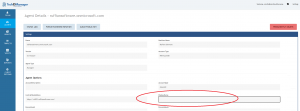As of TechIDAgent.Windows version 2.0 (and newer) the ability to set, on a per agent basis, the format of some of the managed technician’s account information. The user name, the display name, and the account description can all be set from the commandline for TechIDAgent.
As of TechIDAgent.Windows version 3.177 (and newer) the ability to set on a per domain basis the phone and email of the of managed technician’s account.
As of TechIDAgent.EntraID 5.0 (and newer) this agent has this ability too by setting agent options with the same name in the TechIDPortal for that agent.
These examples are for the windows agent, and only show the UserName, but the same string formats works for setting the DisplayName, AccountDescription, email, phone, and several other string based options.
All of these are set based on the same internal variables:
- first – First name from TechIDClient (not assured to be unique among techs)
- last – Last name from TechIDClient (not assured to be unique among techs)
- user – User name from TechIDClient (assured to be unique among techs)
- company – UserNameAddon from TechIDPortal (shared between everyone in the company)
- firstinitial – First letter of the First name from TechIDClient (not assured to be unique among techs)
- lastinitial – First letter of the Last name from TechIDClient (not assured to be unique among techs)
- phone – Phone number from TechIDClient (not assured to be unique among techs)
- email – Email from TechIDClient (not assured to be unique among techs)
- blank – nothing. Use to prevent a value from being set.
To set these on the command line for TechIDAgent they need to in curly braces {}. Any text not in curly braces is used as text. Once set from the commandline they will be used from then on. To clear (or go back to the default value) for any of these options use “reset” as the string after the option. When using PowerShell all options need to be in double quotes (“) because PowerShell will interpret the braces and not do what you are probably expecting. You should use TechIDAgent.exe show to confirm you set the options as intended.
For a few examples lets have a few techs who work for a company with UserNameAddOn – SuperTechs. These names are all made up just for the example, and we really suggest you use realistic names that are easy to identity when looking at AD.
The first tech is John
- User Name – Tech1
- First Name – John
- Last Name- Blaze
The second tech is Eric
- User Name – Eric
- First Name – Eric
- Last Name – Burgin
The third tech is Ethan
- User Name – Master
- First Name – Ethan
- Last Name – Bailey
For example: The command line
TechIDAgent.exe username "admin-{user}.{company}"
will create the following three users
- admin-Tech1.SuperTechs
- admin-Eric.SuperTechs
- admin-Master.SuperTechs
For example: The command line
TechIDAgent.exe username "{firstinitial}{lastinitial}.{company}"
will NOT create the following three users. An error will be sent to the TechIDPortal that you can see when looking at the Domain Status.
- JB.SuperTechs
- EB.SuperTechs
- EB.SuperTechs
This is because there is an overlap in usernames. Note how both Eric and Ethan map to the same username. This will result in the TechIDAgent doing nothing until the error is fixed. Users won’t get created and passwords won’t get rotated.
For example: The command line
TechIDAgent.exe username "{first}"
will create, or take over, the following three users. If there are no users with those names on the network already that won’t be a problem. If one of the names exists already then TechIDManager will take over maintenance on that account, and start rotating the password and setting the rights.
- John
- Eric
- Ethan
This has a high likelihood to overlap with existing and future users on the network, so we recommend against it.
The default for the username is {user}.{company} which guarantees that there is never an overlap in the names created, and minimizes the chance for overlap with existing and future users on the network.
All this applies to username, displayname, and accountdescription. If you want to set spaces in the Display Name or the Account Description then make sure to use quotes (“) appropriately on the commandline.
TechIDAgent.exe displayname "{first} {last} ({company})"
TechIDAgent.exe accountdescription "This is {first}'s tech account for {company} to help manage this network."
As of Version 6.0 agents all options can also be set from the AgentOptions for that agent in the TechIDPortal.
Note: On DomainControllers with TechIDAgent running the managed accounts will be updated to reflect changes in these parameters, as they are changed.
Note: On a non-domain computer with TechIDAgent running, the account names will not be changed when these parameters are changed. The name an account is created with on a non-domain computer is the name it always has. If you manually delete that account a new account will be created based on the current parameters.



